 Afrikaans
Afrikaans  Albanian
Albanian  Amharic
Amharic  Arabic
Arabic  Armenian
Armenian  Azerbaijani
Azerbaijani  Basque
Basque  Belarusian
Belarusian  Bengali
Bengali  Bosnian
Bosnian  Bulgarian
Bulgarian  Catalan
Catalan  Cebuano
Cebuano  Corsican
Corsican  Croatian
Croatian  Czech
Czech  Danish
Danish  Dutch
Dutch  English
English  Esperanto
Esperanto  Estonian
Estonian  Finnish
Finnish  French
French  Frisian
Frisian  Galician
Galician  Georgian
Georgian  German
German  Greek
Greek  Gujarati
Gujarati  Haitian Creole
Haitian Creole  hausa
hausa  hawaiian
hawaiian  Hebrew
Hebrew  Hindi
Hindi  Miao
Miao  Hungarian
Hungarian  Icelandic
Icelandic  igbo
igbo  Indonesian
Indonesian  irish
irish  Italian
Italian  Japanese
Japanese  Javanese
Javanese  Kannada
Kannada  kazakh
kazakh  Khmer
Khmer  Rwandese
Rwandese  Korean
Korean  Kurdish
Kurdish  Kyrgyz
Kyrgyz  Lao
Lao  Latin
Latin  Latvian
Latvian  Lithuanian
Lithuanian  Luxembourgish
Luxembourgish  Macedonian
Macedonian  Malgashi
Malgashi  Malay
Malay  Malayalam
Malayalam  Maltese
Maltese  Maori
Maori  Marathi
Marathi  Mongolian
Mongolian  Myanmar
Myanmar  Nepali
Nepali  Norwegian
Norwegian  Norwegian
Norwegian  Occitan
Occitan  Pashto
Pashto  Persian
Persian  Polish
Polish  Portuguese
Portuguese  Punjabi
Punjabi  Romanian
Romanian  Russian
Russian  Samoan
Samoan  Scottish Gaelic
Scottish Gaelic  Serbian
Serbian  Sesotho
Sesotho  Shona
Shona  Sindhi
Sindhi  Sinhala
Sinhala  Slovak
Slovak  Slovenian
Slovenian  Somali
Somali  Spanish
Spanish  Sundanese
Sundanese  Swahili
Swahili  Swedish
Swedish  Tagalog
Tagalog  Tajik
Tajik  Tamil
Tamil  Tatar
Tatar  Telugu
Telugu  Thai
Thai  Turkish
Turkish  Turkmen
Turkmen  Ukrainian
Ukrainian  Urdu
Urdu  Uighur
Uighur  Uzbek
Uzbek  Vietnamese
Vietnamese  Welsh
Welsh  Bantu
Bantu  Yiddish
Yiddish  Yoruba
Yoruba  Zulu
Zulu Conveyor System Components and Their Essential Functions in Material Handling
The Essential Components of Conveyor Machine Parts
Conveyor machines play a pivotal role in modern manufacturing, logistics, and various industrial operations. These systems efficiently transport materials, products, and components across different stages of production or distribution. Understanding the essential parts of conveyor machines can help businesses optimize their operations and minimize downtime.
1. Belt
The belt is the most crucial component in many conveyor systems. It is the surface that carries the load from one point to another. Conveyor belts come in various materials such as rubber, fabric, metal, and plastic, depending on the application. The choice of belt material influences the durability, flexibility, and weight capacity of the conveyor system. For example, rubber belts are often used for heavy loads due to their high tensile strength, while modular plastic belts are popular for their ease of maintenance and flexibility in configuration.
2. Drive Motor
The drive motor is the powerhouse of the conveyor system. This electric motor converts electrical energy into mechanical energy, driving the belt and enabling it to transport items smoothly. The size and type of the motor depend on the conveyor's load capacity, speed, and length. Proper motor selection can significantly impact the overall efficiency and performance of the conveyor system.
3. Rollers
Rollers are integral parts that facilitate the movement of the conveyor belt. They serve as support points along the conveyor’s length and allow the belt to move with minimal friction. Depending on the design of the conveyor system, different types of rollers can be used, including idler rollers, drive rollers, and return rollers. Properly maintained rollers are essential for reducing wear on the belt and ensuring efficient operation.
4. Frame
conveyor machine parts

The frame is the structural foundation of the conveyor system. It supports all of the components and helps maintain alignment and stability during operation. The design of the frame can vary based on the type of conveyor and the environment in which it operates. For instance, heavy-duty frames are used for heavy industrial applications, while lightweight aluminum frames are suitable for lighter loads and agile production lines.
Modern conveyor systems often incorporate advanced controls and sensors to enhance functionality. These systems can include variable speed drives that allow operators to adjust the speed of the conveyor based on the workflow. Sensors can detect the presence of objects on the conveyor, triggering actions such as stopping the belt or diverting items to different paths. Such features improve efficiency, reduce the risk of jams, and enhance overall productivity.
6. Skirting and Side Bars
Skirting and side bars are additional components designed to improve safety and efficiency. Skirting prevents materials from spilling off the sides of the conveyor, while side bars can help contain materials and keep them on the belt during transportation. Properly installed skirting can minimize material loss and reduce cleanup time, ultimately leading to cost savings.
7. Maintenance Items
Lastly, a well-functioning conveyor system requires regular maintenance. Key maintenance items include lubrication systems, tensioning devices for belts, and replacement parts such as rollers and bearings. Regular inspections and timely replacement of worn-out components can extend the life of the conveyor system and minimize costly downtime.
Conclusion
Understanding the parts of conveyor machines is crucial for businesses looking to enhance productivity and efficiency. Each component plays a specific role in the overall operation, influencing the system's performance and reliability. By investing in high-quality parts and maintaining the conveyor system properly, companies can ensure smooth operations and achieve their operational goals. The right components can significantly impact the bottom line, making it essential to select and maintain conveyor machine parts effectively.
-
Revolutionizing Conveyor Reliability with Advanced Rubber Lagging PulleysNewsJul.22,2025
-
Powering Precision and Durability with Expert Manufacturers of Conveyor ComponentsNewsJul.22,2025
-
Optimizing Conveyor Systems with Advanced Conveyor AccessoriesNewsJul.22,2025
-
Maximize Conveyor Efficiency with Quality Conveyor Idler PulleysNewsJul.22,2025
-
Future-Proof Your Conveyor System with High-Performance Polyurethane RollerNewsJul.22,2025
-
Driving Efficiency Forward with Quality Idlers and RollersNewsJul.22,2025





























